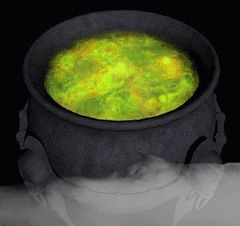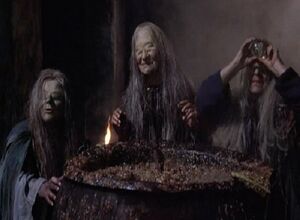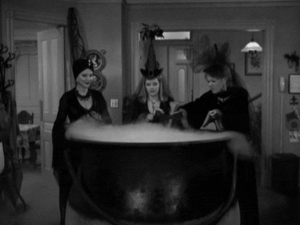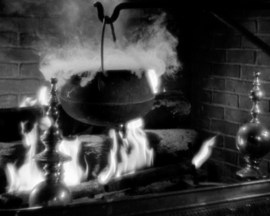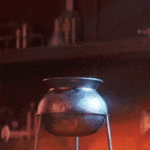Cast Iron Caldron of Catastrophe
The Cast Iron Caldron of Catastrophe a.k.a. Cast Iron Cauldron of Catastrophe, was forged at the turn of the century, 1300 A.D. Originally wrought in the fires of a small-town smithy by a freelance swordsman named only as The Doctor. His cooking skills were renowned in his own village, and his friendship with the local witches gained him access to the Devil's Lair where all the exotic spices and ingredients were stored. The villagers wanted to burn the witches at a stake and replace the cook. And hire another smith. Moreover, they wanted to sue the so-called doctor for malpractice, reckless endangerment, and misinformation.
One night during a full moon and a quarter of the sun, the villagers gathered around and discussed how they might get rid of the doctor and the witches. One of the older men called Al Capone to ask for a favor. The village people, and the village idiot got the goods and began taking orders from Capone on how to go about taking the smith out, and plotted to get the witches to sleep with the fishes. They wanted to rub them out, see? But they didn't have the chops. Having gotten wind of the plot, the doctor and the witches began a club of their own. They called on Capone's rival to help them. What happened next was really bizarre.
The doctor cook smith, and the witches promised to curse something in the village if something should happen to them. When Al Capone showed up with his gang, he couldn't believe how medieval all the people were. He scoffed and started making fun of them. The villagers and the witches shrugged and allegedly had no idea they were actually being made fun of. But the grimacing doctor did catch on. Al Capone was taken to a remote castle to settle in and he was given all this misinformation about the villagers and why he should be against them and not him and the witches. The witches, however, were already in a plot to kill Al Capone.
When Capone's rival showed up, the villagers took him aside and told him and his gang that it was the witches who had brought this on and to not trust them. Being unfamiliar with the witches and their good friend, the doctor, Capone's rival gave the villagers some bags of cement and told them what to do. They began filling up buckets and stirring the cement. One of the villagers who was passing by asked the witches why they were stirring old grey oatmeal in buckets instead of the cauldron. They wondered why they hadn't thought of that before. Then one of the witches asked the passerby why the village wanted to kill them. The response was simply; Because we suspect you're eating the children. The witches said; Why? What have you heard?
The villager stated that Hansel and Gretel claimed that a witch tried to eat them, but they got away. To which the villager added; By the way, there were four of you before, now there are only three of you. What happened to the fourth witch? They looked confused and didn't have anything to say. Al Capone then paid them a visit and attempted to kill the witches. Capone's rival showed up and told him that the villagers and the witches were all crazy and not to listen to them. The doctor cook smith took the cauldron and set it in the village square and announced that the pot had been cursed by the witches, the mafia, and the Church.
In this united moment, everyone shoved the doctor cook smith into the cauldron and proceeded to cook him. He asked why the villagers hated him so much when he was their favorite cook and fed them all so well. But it was the cauldron that made the food so good. The way it evened out the heat inside and never burned anything. They didn't need him. It is said that he escaped from the cauldron and ran away. But because he was chained to it to prevent him from escaping, the cauldron followed him until both he and the pot tumbled over a cliff.
Stirring Trouble[edit | edit source]
A year after the cauldron plummeted off the cliff, a group of townsfolk discovered it and took it back home with them. They immediately put it to good use, knowing nothing about its origins or any curse upon it. It also didn't seem to bother them that a skeleton was chained to one of its handles about two yards away. But as time went on, it did seem to have an effect on people and eventually another cook came on the scene to master the art of the stew. Eventually gaining access to the Devil's Lair to stock up on spicy ingredients. But of course, the Devil has a price. Things had gone up and instead of one gold coin for a month's supply of garlic and onion powders, it was now two gold coins. No matter, the chef was Italian and there was no way he was going to cook without them.
A few months later, the townsfolk started suspecting that the cast iron pot had some odd features about it. By that time, they had removed the chained skeleton and anything else that made it cumbersome, but every time it was used, it seemed to have a glow about it. Sometimes it was a reddish glow, other times a green or orange glow. One time it glowed with a kind of plaid motif. The townsfolk thought it could be from Scotland. Then there were murmurs that it was Greek and that it had once been owned by the Stygian Witches who would use it to cook people in when they wandered into their lair. Unnerving the townsfolk, they wanted rid of the thing. But the cook that used it protested.
At one point when several people were cleaning and drying it, before seasoning it, they tipped it upside down to see if there were any trademark signatures on the bottom of it. Sure enough there was a date: 1300 A.D. and what appeared to be a suggested recipe. But because it was in plaid, nobody knew what was engraved into it. Nevertheless, the cook called everyone paranoid, superstitious, fraidy cats, and conspiracy theorists. Pointing out that the Stygian Witches lived thousands of years before 1300, and that they were just being silly. The townsfolk felt it was their duty to consult the oracles and the god of the volcano about the cauldron. Then threw a pinch of salt over their shoulders and turned in a circle three times while chanting that good luck be with them.
The god to whom the simpleminded townsfolk prayed – Mount Etna and Mount Vesuvius are both active – apparently didn't like their bothering him about a damned pot and went back to sleep. The pro-cauldron cook laughed at them and teased them about their volcano. No sooner had he done that, all the volcanoes synced up and erupted. The damage was catastrophic, but the cauldron simply floated away on a wave of molten lava and ended up washed ashore in some other land.
For many hundreds of years the cauldron sat on the beach and did nothing. Eventually someone was bound to find it. A promising soup chef stumbled upon it, and after screaming and cursing for the pain he felt running into a blunt cast iron monstrosity buried almost entirely in the sand, he took it home. He began a very successful soup shoppe in New York City. He suffered for his soup, not because the soup was difficult to make, but because every time he used the cauldron, he would remember the excruciating pain he suffered when he first encountered it. He would sometimes whisper something mean and spiteful at the cauldron when no one was looking. He hated it as much as he loved it. But his success would be short-lived when one of Jerry Seinfeld's girlfriends found his recipe stash and put him out of business. He not only went out of business, he was mocked and called a Soup Nazi on top of that. But so many people who loved his soups were outraged and saddened. Many New Yorkers starved to death in protest of the events that unfolded. In the end he cursed the cauldron, as so many did before him, and dumped it off at the Salvation Army.
Boiling Over, Oozing & Bubbling[edit | edit source]
The fate of the cast ironed curse would be unknown sitting in the basement of a donation center until one afternoon, during a foggy October haunting of said donation center. Amateur witches happened to find it after employees failed a simple séance and caused a great deal of disturbances with their bumbling. The witches didn't help the situation, either. But there they did find a great bargain and purchased the cauldron. Because they were well versed in all things witchy, they could read the recipe engraved in the bottom of their new item. They weren't very skilled with cooking in general and managed to barely boil water, so their experiments using the cauldron was at best, a decent attempt. Besides not knowing that wooden spoons would help in keeping the pot from boiling over, they also had quite a few accidents with some disgusting brews that slimed over the edges and simmered away on the floor until it was safe to mop it up. When they felt they were ready, they prepared to cook the recipe as was written at the bottom of the cauldron.
Double Toil & Troubles[edit | edit source]
Translating the words of the cauldron, the witches discovered that whoever owned it previously wanted this guy Macbeth really dead. Given that the witches were successful in keeping an entire donation center haunted, they were going to attempt to take down Macbeth. The donation center was haunted by ghosts who wanted to be near their old stuff, so they asked if there was ever a donor who could be connected to this Macbeth dude. The list was extensive, but it was on good authority that some of his relatives or co-workers might have donated some of his things. The list of possible leads was Romeo and Juliet, Hamlet, and King Lear.
The double double was easy enough. They stirred and chanted those words as the recipe called for it. Fire burn and cauldron bubble, check. But they couldn't understand that if this major psycho Macbeth had to be dealt with, why would it be that the cauldron insisted on involving innocent bystanders. These witches apparently did have morals and were decent and not at all into cannibalism. This needed more looking-into.
Fire Burn & Bubbles[edit | edit source]
The standard desk clerk called them back and asked the witches why they wanted a backlog of anyone connected to this Macbeth guy. They informed the lady that Macbeth must be brought down and dealt with in a sense of extreme prejudice. Asking why they were attempting to quote, unquote, bring down an already dead guy the witches responded with; It's the principle of the thing. So that was settled.
Continuing on with their cooking, the fillet of a fenny snake confused them as they didn't know exactly what that was. So they substituted a fillet of fish and shake'n bake, to which it was to be placed in the cauldron to boil and bake. One of the witches went on with; Well now wait a minute, why boil something only to bake it afterward? That seems kinda redundant, don't it?
Yet the next part of the recipe was even more disturbing. Eye of newt and toe of frog, wool of bat and tongue of dog. They all agreed that no one was going to take any eyes away from Newt. They knew Newt Gingrich was an idiot but they weren't going to gouge his eyes out. That was way below their level. And the toe of a frog was as they put it; as stupid as a rabbit's foot. Why on earth go after a poor frog? They also noted that the recipe must have had some instructions left off the pot because since when do bats have wool? They knew sheep had wool, but what was the deal with bats? They wondered how one would actually shear a bat. It was crazy. And the tongue of a dog. This was not going to happen. Even their cats agreed; leave it alone.
The recipe also called for adder's fork and blind-worm's sting. The adder may have been the silly fenny snake mentioned earlier, and they already had that covered. Also adding that worms were blind by nature and they don't sting. So they put in a gummy worm and a small jar of honey made from bumble bees. However the lizard's leg and owlet's wing were going to have to be substituted with a box of chicken parts from KFC. For a charm of powerful trouble, like a hell-broth boil and bubble. Okay again, there's that boil and bubble bit. If something is boiling it would stand to reason that it was bubbling. So the recipe is redundant as hell. Said the second witch to which the third witch pointed out that it was supposed to be like a hell-broth. The other witches slapped the third for being so stupid.
Boil Your Own Charms & Get The Hell Away From Me[edit | edit source]
The witches got back to trying to make the potion, the dish, charm, whatever. They went on to read; Witches' mummy, maw and gulf of the ravin'd salt-sea shark. This was no good. Not only were they amateurs, they certainly weren't into practices that dated back to ancient Egypt; therefore not one of them had any mummies. Also a shark's mouth and what they guessed was the back fin of the shark, wasn't something they were even going to consider trying to obtain. Sharks being part of the recipe called for someone to either know how to catch a shark or to risk being killed him or herself. So they crossed that off the list.
Root of hemlock digg'd in the dark, now it was getting somewhere. This was easy, they did that all the time. Liver of blaspheming Jew. Another redundancy, but no problem. Gall of goat, and slips of yew. What's with this Mexican crap? One of the witches asked, and again they had to substitute it with a cow's stomach. Slips of yew were added since that grew wild in their backyard. Sliver'd in the moon's eclipse, was now going to be a problem since the yew they had access to had some time to go before being "silver'd" during a lunar eclipse.
Nose of Turk, and Tartar's lips, nope. Finger of birth-strangled babe, aw hell no! Incidentally it was actually the name of an herb. Ditch-delivered by a drab. Yeah this is all such bullshit and they all agreed that the cauldron was one fucked up pot. Make the gruel thick and slab. Not gonna happen. Add thereto a tiger's chaudron, another plant but a really sadistic name for a plant since it was named to indicate a tiger's entrails. Cool it with a baboon's blood, fuck you, cauldron. Then the charm is firm and good. Shaking their heads they realized there were some real freaks who lived in the 1300s and took what was already made and told Macbeth to stay the hell and gone from them.
Modern Day Hearths vs The Pits of Hell[edit | edit source]
The infamous cursed cast iron pot was eventually given back and shortly afterward the Salvation Army's donation center eventually became too unstable to store and donate old items due to severe natural disasters. A few ghosts still hung around but the more showy ones took off. This wasn't the end of it, though. A museum curator wanted to feature the antique in its original setting, comparing it to modern day kitchens and those used back in the day. It was the Devil himself who showed up and insisted that it was his property. It wasn't but, he's a liar. Knowing the pot from ages ago when he used to sell spices throughout Europe, he knew the pot quite well. He knew what kind of trouble it could cause. And he knew of all the curses placed upon it. Whereas before he really had no interest in it, now he did.
The museum curator cut a deal with the devil, of course. When the center spoke of the last time it was even used, they spoke of it as though it was a bad omen. That it was indeed used by witches who reported it to be a very bad investment and that the recipe it comes with was very gruesome and could give someone food poisoning. The Devil scoffed and called them amateurs. The curator featured the cauldron as an exhibit of what cooking was like before modern day cookware was mass produced, made of aluminum and other inferior materials. But as the art set gained more attention, people started insisting on using cast iron for all their cooking needs. As anyone might have predicted, cast iron started wiping the proverbial floor with all other brands of cookware. People started crafting their own cast iron pots, and making recipes similar to the original accursed recipe found on the original cast iron cauldron of catastrophe. The museum was subsequently sued by high end name brand makers of cookware like Farberware and Corningware. None of them could produce cast iron like the general population could given their access to backwoods, po-dunk towns, and abandoned iron mines. Not to mention there was always an endless supply of witches (mostly amateur) that knew how to get a hold of this stuff.
The museum won in court but had to scrap the exhibit on the grounds that people would hide in the cauldron when no one was looking, wait for closing time, and get to work stirring double, double, toil and trouble, and so on. The dictators of the world demanded the exhibit to be torn down, replaced by a giant leech exhibit, and that the cauldron be destroyed. The museum suffered so much backlash and abuse that they eventually had to close down. The devil then came along and built a structure in place of the museum, featuring a giant hole that was fenced off and open only to those serious about using the restored cauldron. The most endearing features of pot stirring were flash floods, seismic activity, destructive whirlwinds, coastal areas turned into new coastal areas, World War III, and an obscene number of crows.
